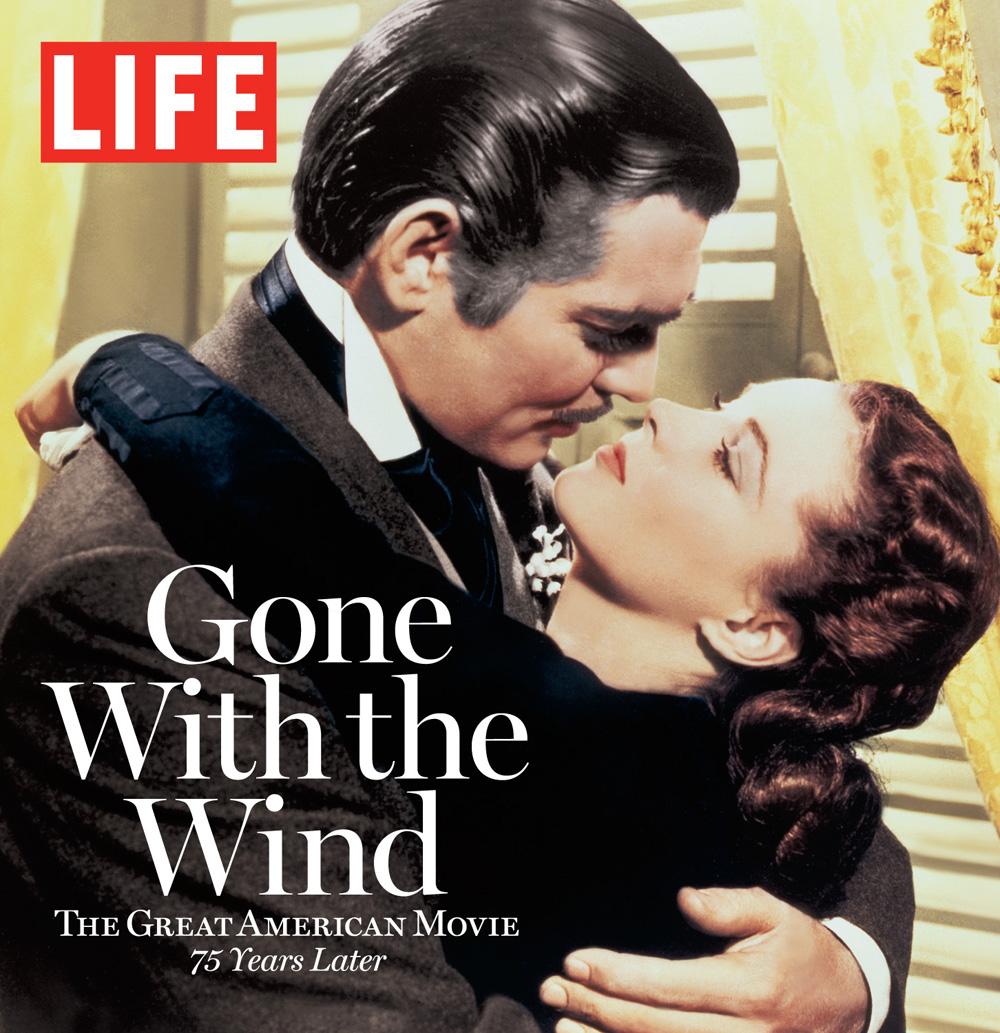The Rocky Road to Tara
It took three years, cost a princely sum and threatened to go off the rails more times than David O. Selznick cared to count. But against all odds, Gone With The Wind stayed the course–and turned out to be an epic for the ages.
by Chris Nashawaty

Courtesy Everett Collection
Katharine Brown was one of David O. Selznick’s most trusted employees. Her job—and it was a 24-hour-a-day one—was to scour New York’s publishing circles and sniff out unproduced properties that her hard-driving boss could spin into box-office gold. As the mercurial, 34-year-old movie mogul’s official East Coast story editor and unofficial gal Friday/arbiter of good taste, Brown needed to have lightning-quick instincts and the thick hide of an elephant. After all, Selznick was notoriously demanding and infamous for his short-fused three a.m. phone calls. It wasn’t easy keeping pace with a mind that whirred as feverishly as Selznick’s. But Brown was one of the few movie executives who could keep up.
On the afternoon of May 20, 1936, she fired off an urgent Teletype to her employer. The message read: “ . . . have just airmailed detailed synopsis of Gone with the Wind by Margaret Mitchell, also a copy of the book . . . This is an absolutely magnificent story . . . a great literary property and we must have it . . . The book is 1,000 pages long and I have only gotten through half of it, it is one of the most lush things I have ever read . . . I am absolutely off my nut about this book . . . I beg, urge, coax and plead with you to read it at once . . . I know that after you do you will drop everything and buy it.”
In fact, Selznick did not drop everything after reading Gone with the Wind. He didn’t even crack its imposing spine. Instead, he relied on the 150-page synopsis that Brown had given him, poring over it while on vacation in Honolulu. Selznick knew that the success of adapting Mitchell’s novel would depend on casting. Even though he was a compulsive gambler who lived to place exorbitantly large bets—whether in the boardroom or at the horse track—he balked at the book’s rich $50,000 price tag. But like all gamblers, he lived in a constant state of fear that someone else might rake in a pot that he felt rightfully belonged to him. He wasn’t sure he wanted Gone with the Wind, but he was certain that he didn’t want anyone else to have it.
So after several weeks of hemming and hawing, on July 6, 1936, Selznick finally relented to Brown’s impassioned pleas, opened his checkbook and paid a king’s ransom for the movie rights. It would be the easiest decision and the most incident-free moment of the next three years.
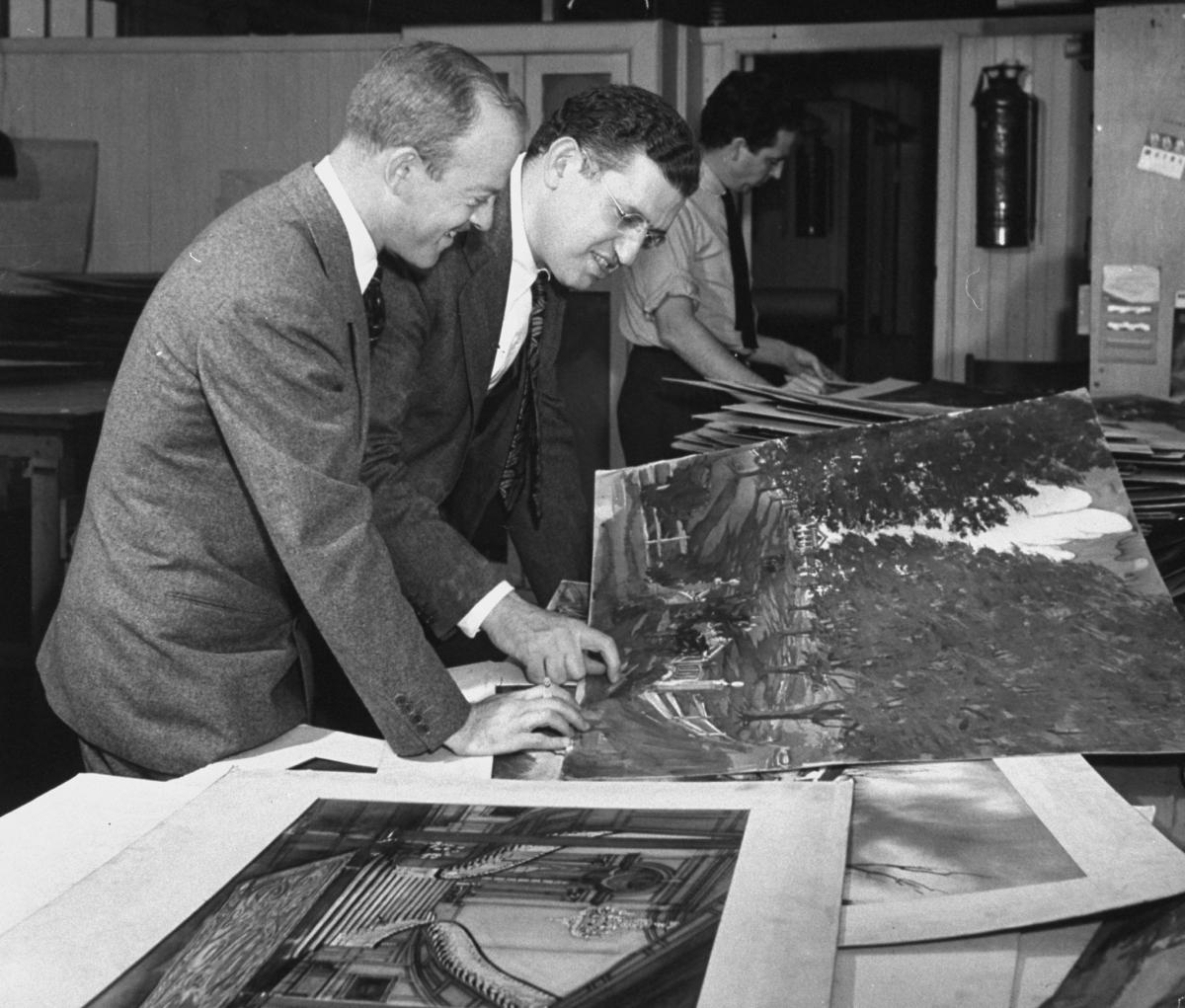
Selznick (center) studies production design paintings with art director Lyle Wheeler (left).Peter Stackpole—The LIFE Picture Collection/Getty Images
It seems fitting that David O. Selznick was raised on a Hollywood back lot. His father, Lewis J. Selznick, was a Ukrainian Jew who gave up a thriving career in the jewelry business in Pittsburgh to move his family west in 1920. Lured by the siren’s song of glitz, glamour and easy money that the fledgling silent-movie industry promised, the elder Selznick amassed and squandered several fortunes during his lifetime before finally going bankrupt in 1925 and retiring from the film business. Still, his sons, who had grown up tagging along with their father to daily studio meetings, never doubted that their futures resided in Hollywood’s dream factory.
The eldest son, Myron Selznick, would become one of the most powerful talent agents in town, while David quickly established himself as one of the most agile minds in motion pictures, rapidly bounding up the studio ranks at Metro-Goldwyn-Mayer, Paramount and RKO, where, as the head of production, he oversaw 1933’s classic King Kong.
That same year, Selznick returned to MGM, which was now being run by his father-in-law, Louis B. Mayer. There, Selznick established himself as an indispensable producer of lavish, spare-no-expense prestige pictures, including Anna Karenina, David Copperfield and A Tale of Two Cities. Yet he burned to be his own man. He left MGM in 1935 to launch Selznick International Pictures, leasing RKO’s 40 Acres lot in Culver City. By the end of 1936, his first year as an independent, Selznick had produced The Garden of Allah, with Marlene Dietrich, started preproduction on his next spectacle, The Prisoner of Zenda, and acquired the rights to what would become the greatest undertaking of his career—the film that would place him on the same elevated plateau as his father-in-law and the other titans of Tinseltown: Gone with the Wind.
Even with all of his experience in the shovel-and-spade trenches of Hollywood moviemaking, Selznick wasn’t quite sure how to turn Mitchell’s doorstop of a novel into a film. The only thing he seemed to be sure of was that he wanted George Cukor to direct it.
Cukor had already directed five pictures for Selznick, including What Price Hollywood? and Dinner at Eight. Both men had reputations for being demanding, but they shared an artistic sensibility in their quest for perfection. Cukor was regarded by the industry as perhaps its greatest director of women. He had just shepherded Greta Garbo through Camille for MGM, and he possessed a natural, almost fatherly sensitivity for his leading ladies. He seemed the ideal candidate to shape a memorable performance from whatever actress Selznick ultimately chose as his Scarlett O’Hara—even if the director wasn’t as impressed with Mitchell’s book as Selznick was. “I didn’t think it was the second coming of Christ,” Cukor said years later. “It was an effective, slightly crappola thing, but a damn good story with some very original things in it.”
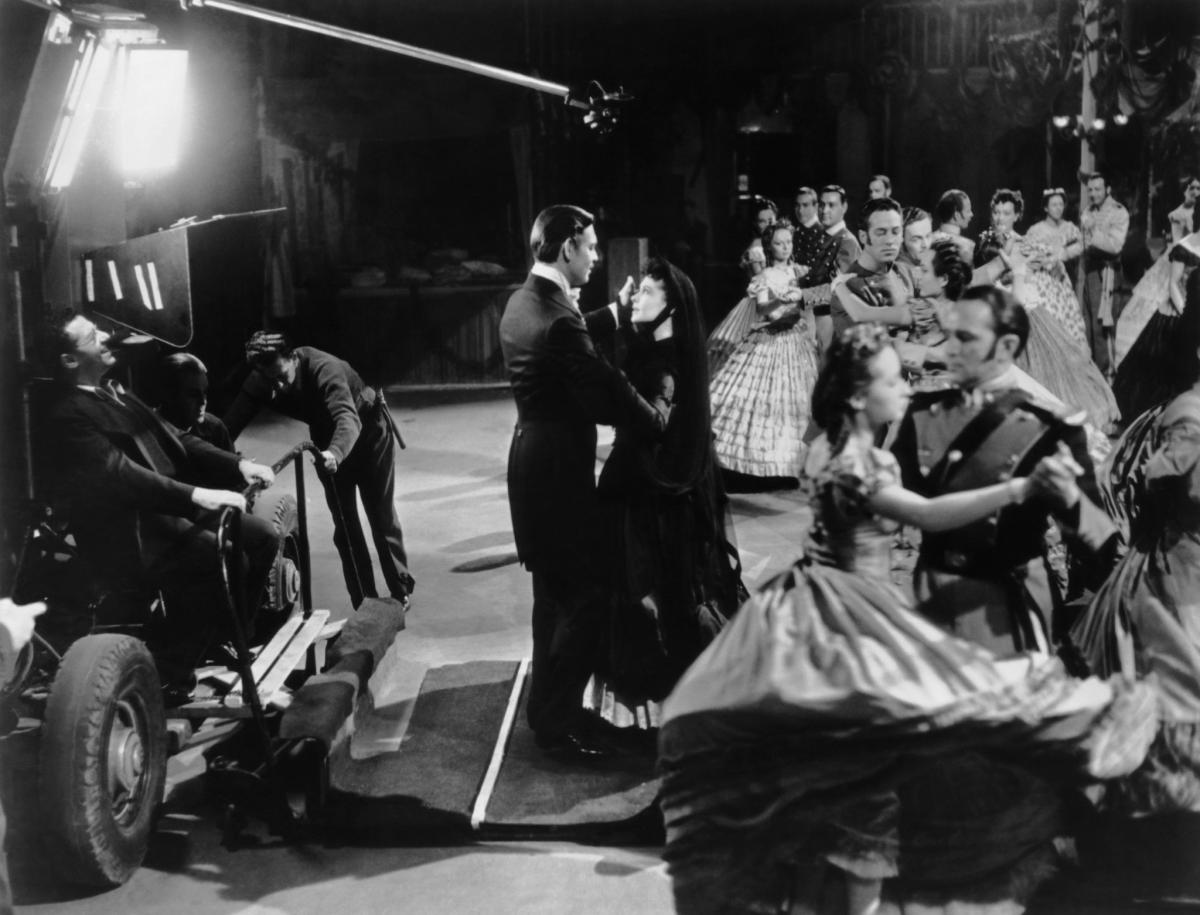
George Cukor (above, far left) watches with delight as Gable and Leigh film the Monster Bazaar charity ball sequence.Courtesy Everett Collection
Both men wanted veteran screenwriter Sidney Howard to have first crack at adapting Gone with the Wind. Mitchell’s novel would need to be mercilessly streamlined without sacrificing its historical sweep or smoldering air of moonlight-and-magnolias romance, which millions of readers had come to adore. It was no small task. And one that Mitchell herself couldn’t fathom, calling her creation “unfilmable.” (Of course, that didn’t stop her from cashing Selznick’s check.) Howard, a Pulitzer Prize–winning playwright who had recently adapted Sinclair Lewis’s Dodsworth for the screen, took the assignment in October 1936, under one condition: that he work alone, free from Selznick’s infamous meddling, 3,000 miles away on his farm in Massachusetts. Selznick reluctantly agreed.
The job would take time, and Selznick wasn’t known for his patience. While he waited, he decided to whip up anticipation for the film by turning the casting of Scarlett into a national obsession. Impassioned letters poured in to the Selznick International offices, with housewives from Portland to Poughkeepsie offering their two cents on who should play Mitchell’s sassy Southern belle. Bette Davis, Katharine Hepburn, Paulette Goddard, Joan Crawford and Barbara Stanwyck were just a few of the names garnering write-in votes. Meanwhile, Brown was dispatched to go on a whistle-stop rail tour of the South in search of an unknown to play the most-talked-about literary creation in decades. For the role of Rhett Butler, Selznick flirted with Errol Flynn, Gary Cooper and Ronald Colman. But his—and America’s—first choice was Clark Gable, who was under contract to Selznick’s father-in-law at MGM. The bare-knuckle businessman Mayer was in no mind to help out a competitor, relation or not.
In March 1937, Howard finally delivered his first draft of the script. It was long enough for a five-and-a-half-hour movie. Selznick was incensed. And for the next several months, the producer put Howard through the wringer to incorporate his laundry list of revisions. The changes would eventually add 15 pages to Howard’s next draft. Sensing no end to the misery, Howard decided that he wanted out. Selznick was only too happy to let him walk.
By June 1938, without a single actor cast, no workable script in sight and financing as yet unsecured, Selznick had already blown through $400,000 of his own money. The producer now needed an angel investor with deep pockets to swoop in and save the day. He didn’t have to look very far to find him.
Louis B. Mayer possessed two things that Selznick desperately required: limitless capital and Gable’s contract. In August 1938, Mayer agreed to loan his top star and $1.25 million in cash to what was quickly becoming his son-in-law’s very public folly. In exchange, MGM would receive worldwide distribution rights and half of the film’s profits over the first seven years. Selznick jumped at the offer. He didn’t have a choice. Gable didn’t appreciate being farmed out like chattel for a movie he didn’t particularly want to star in, but Mayer silenced the actor’s objections by financially helping him with his divorce so he could marry the actress Carole Lombard.
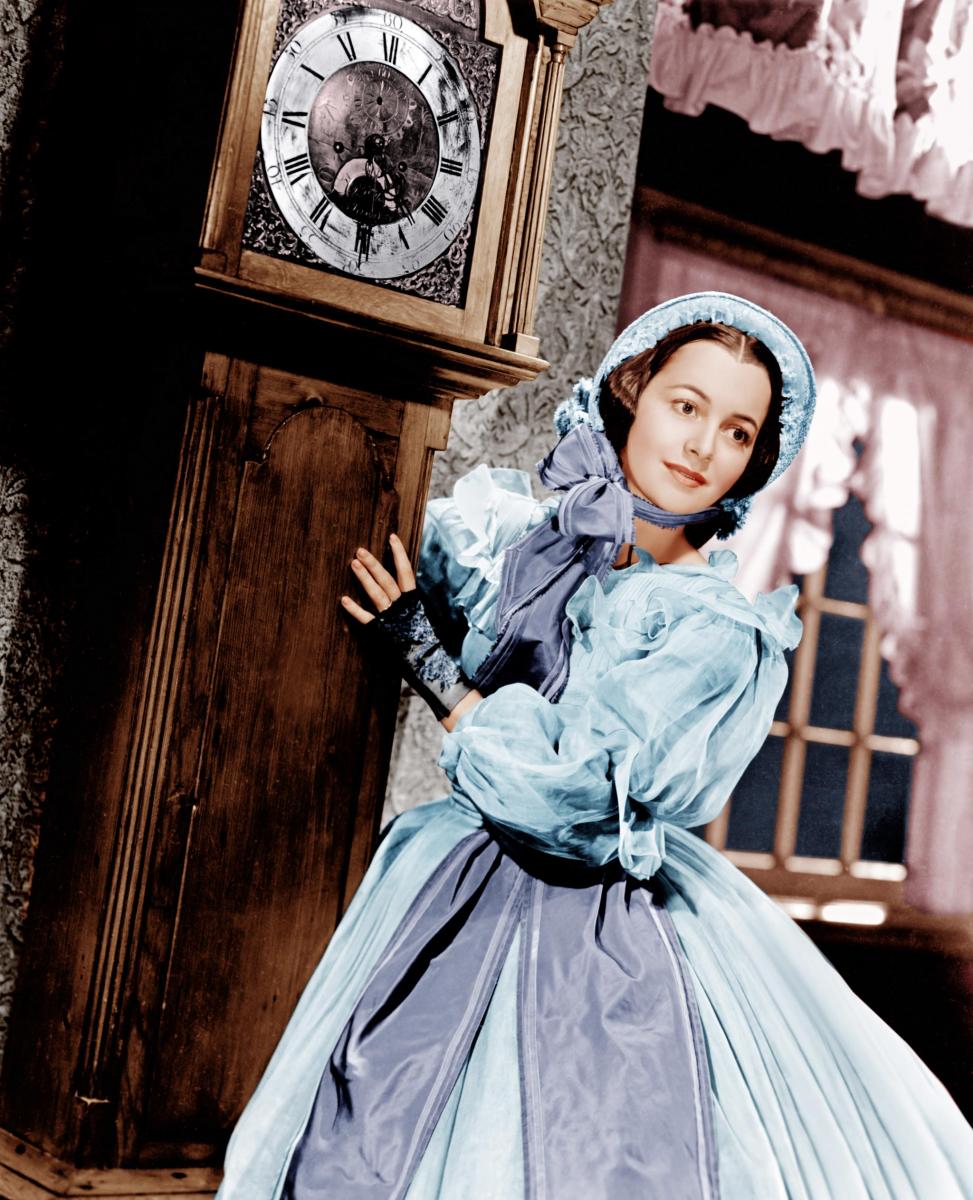
De Havilland looks peacefully pensive in her Twelve Oaks barbecue gown, which the actress called “marvelous. It so expresses Melanie’s character.” She did, however, feel that the original design had one too many ruffles on the skirt. Selznick agreed and asked Plunkett to rework the costume with three ruffles instead of four.Courtesy Everett Collection
Before shooting was set to begin, in January 1939, Selznick went to Bermuda for some sorely needed R&R, hauling along four suitcases filled with various drafts of the script. He quickly realized that he’d have to swallow his pride and ask Howard to return. Selznick pleaded with the battle-scarred scribe to come back on the project, but Howard refused. Selznick cycled through a string of second-choice screenwriters, including Oliver Garrett, John van Druten and even F. Scott Fitzgerald. He rewrote them all.
And still, Scarlett eluded him. Cukor had always envisioned Hepburn in the role. The 31-year-old Oscar winner had already starred in Little Women, Morning Glory and Alice Adams. Years earlier, Hepburn had even lobbied RKO to buy the rights to Mitchell’s book for her. She and Cukor argued their case before Selznick, but the producer couldn’t be convinced. He didn’t think Hepburn had sex appeal. In the back of his mind he’d begun to settle on Goddard. But deep down, he wanted a newcomer—someone whom both he and the public would feel like they’d had a hand in discovering.
Vivien Leigh was a relatively unknown 25-year-old British actress who also happened to be Laurence Olivier’s lover. In the winter of 1938, she and Olivier came to Hollywood—he to star in Wuthering Heights, she to finagle an introduction to Selznick, who was in possession of the role she yearned to play. Ever since first reading Gone with the Wind, Leigh had become convinced she was Scarlett O’Hara. When she arrived in Los Angeles, she shrewdly signed on with Myron Selznick as her American agent.
Myron brought his fresh-faced discovery to Selznick International to watch his younger brother film the burning of Atlanta sequence. Even though he wouldn’t be ready to start filming in earnest for several months, Selznick needed to get something in the can. The lot was still crowded with sets from RKO’s past glories King Kong and The King of Kings, which would now be serving as kindling for Gone with the Wind’s most spectacular set piece. Stunt doubles for Rhett and the still-uncast Scarlett were filmed from afar, their faces obscured as they raced in a horse-drawn carriage through the inferno.
During the epic shot, Myron walked up to his brother amidst the flames and introduced him to Leigh with the line “Hey, genius, meet your Scarlett O’Hara.” After two years of searching, could it really be this easy? Indeed it was. On Christmas Day 1938, Leigh was told she had the part. A few weeks later, Leslie Howard was signed to play the object of Scarlett’s desire, Ashley, and Olivia de Havilland was cast as her future sister-in-law, Melanie.
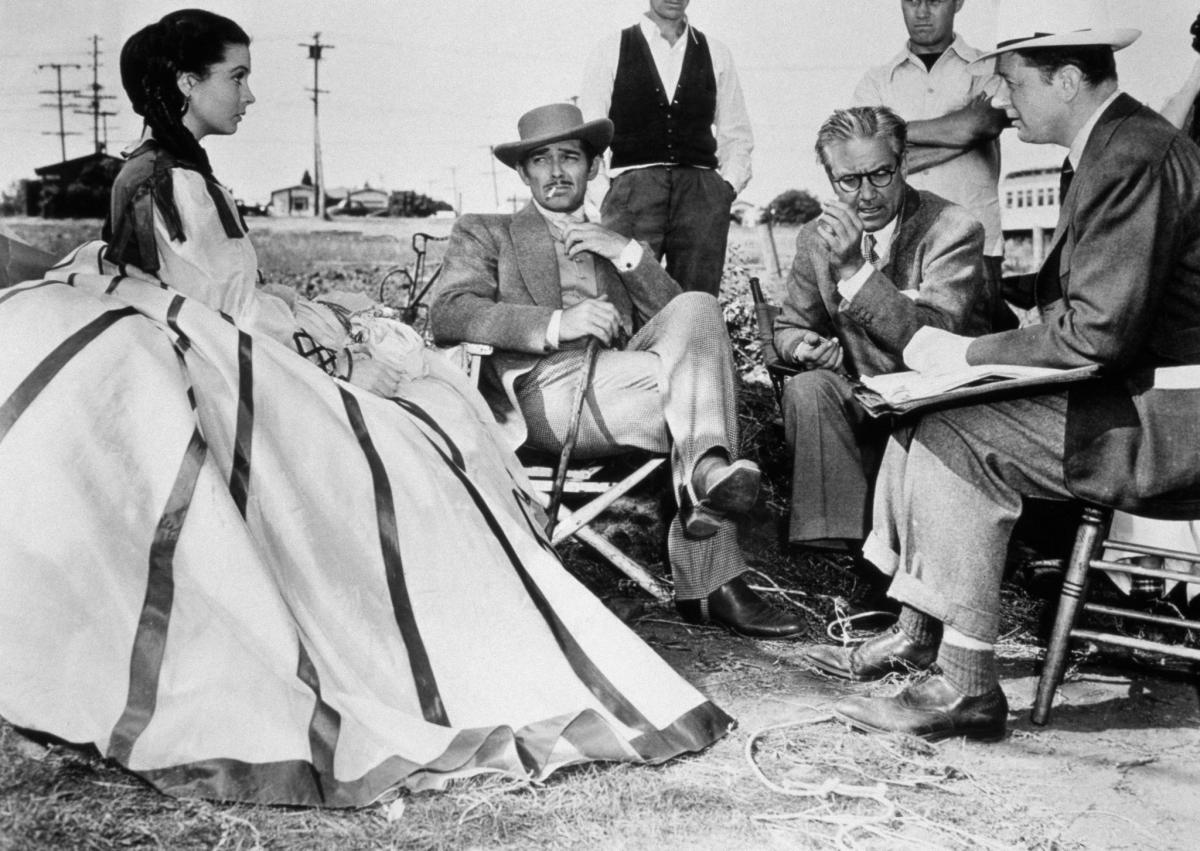
Leigh, Gable and Fleming take a breather on set.Sunset Boulevard/Corbis
On January 26, 1939, principal photography finally began on the Culver City back lot. But despite all the months of chaos and melodrama, the trouble was just beginning. Selznick had torn through so many writers he decided to rewrite the final script himself, fueling his all-nighters with Benzedrine and Scotch. Leigh, who was cloistered for several hours every day with a dialect coach to help disguise her British accent, was told by Selznick that she would no longer be allowed to live with Olivier while making the film. Although the producer had once courted publicity for his movie, he could not afford to stir up any more headlines.
Meanwhile, Gable stubbornly refused to speak in a Southern dialect as Rhett, and it was becoming clear to everyone on the set that he and Cukor were not getting along. The director had a kinship with Leigh and de Havilland, but he could not work with Gable. After the first 10 days, Cukor had shot just 23 minutes of film—half of which had to be reshot. Selznick was apoplectic over the director’s snail-like pace. Cukor blamed the script and argued for Howard’s first draft to be restored. Selznick had heard enough. Cukor was out.
Leigh was crushed. She adored Cukor and now, without him, she was feeling insecure, alone and adrift. She later said, “He was my last hope of ever enjoying the picture.” Selznick’s choice as a replacement was Victor Fleming, an imperiously macho director who was in the middle of filming The Wizard of Oz for Mayer’s MGM. Again, Selznick’s father-in-law would come through, tearing Fleming away from Munchkinland and reassigning him to Selznick’s fiscal sinkhole.
Fleming was one of the top directors in Hollywood. Even better, he was Gable’s pal—the two had recently made 1938’s aerial adventure Test Pilot together. In February 1939, Fleming dutifully reported for work at Selznick International. Already behind schedule, Gone with the Wind was shut down so its new director could get up to speed (the cost: $10,000 a day). Fleming took one look at Selznick’s mammoth screenplay and brusquely informed his new boss, “You haven’t got a script.” Ben Hecht was called in for rewrite duty. The overhaul had to be done so quickly that Selznick decided Hecht shouldn’t even bother opening Mitchell’s book. Instead, he and Fleming stayed up all night acting out the story for him—a pantomime fueled by pep pills, adrenaline and panic. Hecht cranked out a draft in two weeks.
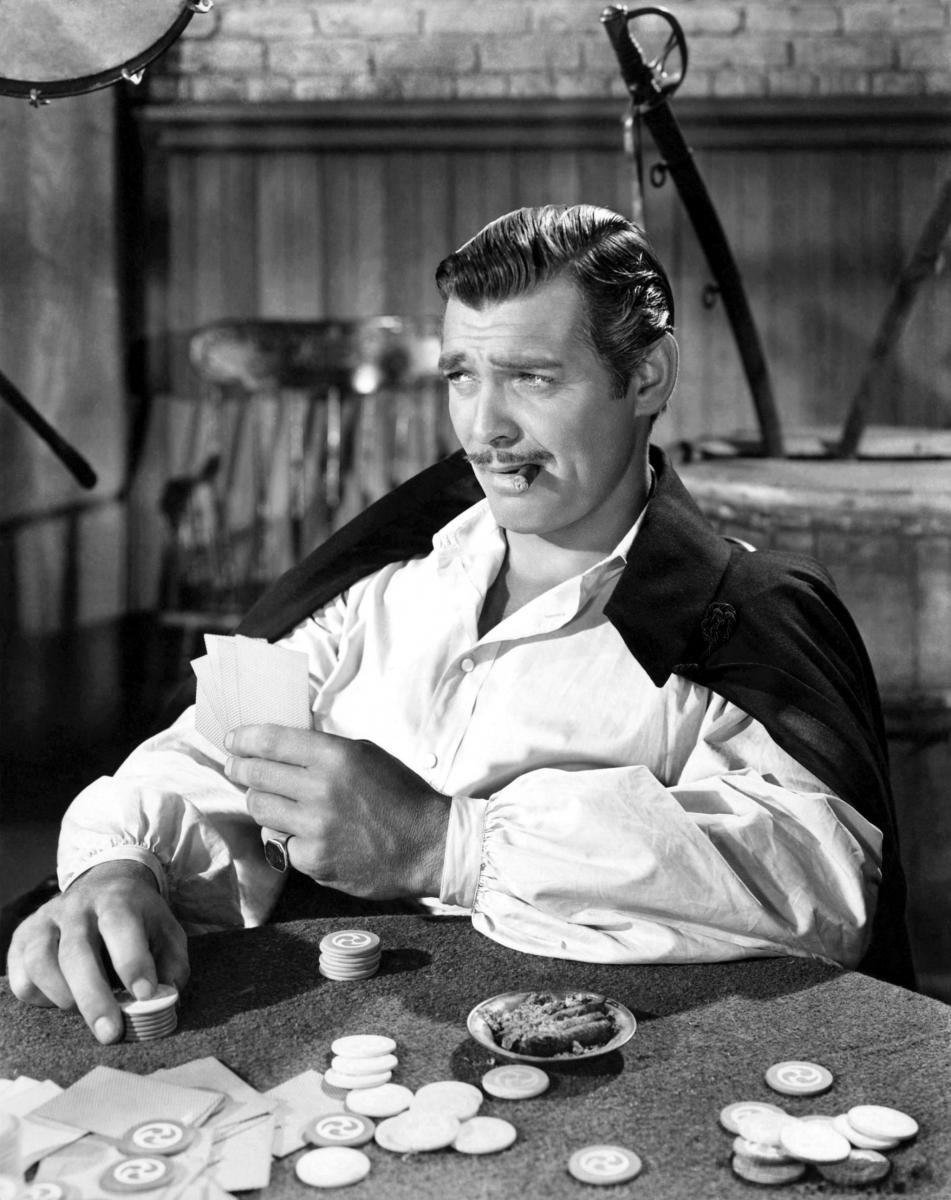
Rhett Butler, still exuding cool even when jailed by the Yankees. Scarlett visits him in prison to ask for money to pay the taxes on Tara. He says, “You’re not worth $300. You’ll never mean anything but misery to any man.”Cineclassico/Alamy
Back on the set, Fleming proved to be just the shot in the arm that the production needed. He was a tireless field marshal whose abrasive manner and salty patois appealed to the beleaguered cast and crew—everyone except Leigh, with whom he quarreled constantly. And there was more strife elsewhere. Unhappy with the footage, Selznick fired the cinematographer, Lee Garmes, and replaced him with Ernest Haller. Several other key technicians were purged by the frazzled producer, whose stomach was by now coated in ulcers and whose hair had turned completely gray. The film continued to go over budget, and this time, Selznick’s father-in-law was of no mind to bail him out. So the producer turned to financier John Hay “Jock” Whitney, who staked Selznick $1 million of his own fortune to keep the cameras rolling.
Then, on April 29, Fleming abruptly walked off the set. The official story was that he had suffered a nervous breakdown. That excuse was understandable given the circumstances, but others suggested that Fleming’s departure was actually a power play aimed at his dictatorial boss, that he wanted to put an end to Selznick’s incessant meddling. Marcella Rabwin, Selznick’s executive assistant, recalled, “It was a case of utter chaos . . . I have never known so much hatred . . . Leigh hated Fleming. With a passion. Fleming hated her. Clark Gable hated David . . . Everybody hated David. He interfered in everything . . . Everything had to be done and redone.”
With Fleming AWOL, Selznick cast his net for a reliable replacement and found the Goodbye, Mr. Chips director, Sam Wood. Sixteen days later, Fleming returned. He had either steadied his nerves or, more likely, been scared straight by the fact that Wood was getting along swimmingly with the punch-drunk crew. Selznick now had two directors—and he kept both. There was certainly enough work to go around, including the movie’s biggest and most technically challenging scene: the iconic casualty sequence at the Atlanta railroad depot. It was a staggeringly complex crane shot involving 800 extras posing as injured soldiers writhing on the ground as Leigh’s Scarlett frantically moves through the crowd. The camera was to pull back and reveal a sea of tortured humanity and the Confederate flag in tatters—the price of war captured in one dazzling, haunting Technicolor image. Despite sweltering heat, Fleming’s shot went off without a hitch . . . after seven takes.
On June 27, 1939, production finally wrapped. It took 125 days of photography, 37 months of preparation, half a million feet of film and a budget of $4.25 million (at a time when the average feature cost less than $1 million). Selznick’s personal war was finally won. The next four months in the editing room, where music and matte shots would be added, would hardly be uneventful. But at least they happened out of the sight of the gossip mavens and the cynics.
All that was left was to find out what the public thought. On September 9, 1939, 54 cans of film arrived at the Fox Theatre in Riverside, California, for a sneak preview. The movie advertised on the marquee that evening was Beau Geste, starring Gary Cooper. The audience was treated to something very different—and the place went crazy. Reaction cards filled out after the end credits rolled begged the filmmakers not to change a thing. It finally looked as if the biggest gamble of Selznick’s career—a bet that had nearly broken him physically and financially—was about to pay off.

Scarlett perfects her pout, standing alone, yet still at the center of everything at the Twelve Oaks barbecue.Selznick International Pictures/Ronald Grant Archive/Alamy
